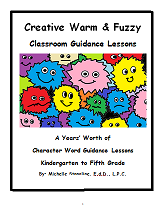The Kinetic Family Drawing Test in Beyond Art Therapy
I first learned about the Kinetic Family Drawing Technique from a school psychologist who uses this valuable art therapy tool in educational testing.
Later, I applied the Kinetic Family Drawing to the doll house in play therapy and then to Shelter House Therapy and with the Beyond Art Therapy Technique (See Link Below).
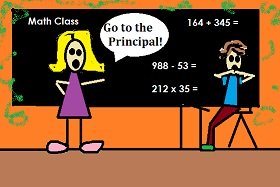
The Kinetic Family Drawing Test was developed by Burns & Kaufman. You can use a modified version of this test with your clients and students. It is a very helpful technique for a certified, or licensed, professional to keep in their counseling tool box.
The good news is that you do not have to be an art therapist to use this. You do need to be a professional mental health provider, preferably licensed, with some basic art therapy training. You can get some Beyond Art Therapy training in the eBook in the right hand column of this page.
Basically, the Kinetic Family Art Therapy Drawing Technique will help you reveal answers of the following:
- The therapist will see how the client sees themselves in the family unit.
- Interaction between the child and family members can be measured.
- The “nuclear self” in the client.
- If the client is an adult, the therapist can see the sense of self from childhood.
- The therapist can see the hidden rules in the family that are not easily seen from the outside looking in.
- Internalized feelings from the child and other family members.
- Who is the most important person in the family, to the least important in the family?
- Who is close in the family and who is not close in the family?
There are five basic elements to the Kinetic Family Art Therapy Drawing that need to be analyzed and interpreted. Below you will find the five basic elements:
1. Placement within The Kinetic Family Drawing:
The Kinetic Family Drawing Placement Grid basically analysis where family members are placed in the drawing. Who is standing next to whom? Are they closely drawn, or far away? Who was drawn first, middle, last, and who was omitted in the drawing? Who was added, yet erased, or moved in the drawing? Who is the largest in the drawing and who is the smallest? Is this true to the scale in real life of each person represented?
2. Physical Characteristics
Look at the physical characteristics of each person in the Kinetic Family Drawing. Are body parts exaggerated or omitted? Look at the clothes? Facial features? Colors used?
3. Actions of the Figures
Basically in this part of the Kinetic Family Drawing the therapist will analyze what each family member is doing and with whom. Who is left out here? Who is included in the action? Who is the leader and who is the follower?
4. Freudian Symbols
Look for these in the Kinetic Family drawing. They can also be a projection for something going on that is hidden.
5. The Style of the Kinetic Family Art Therapy Drawing (The Family System as a whole.)
This is where you can see the internalized feelings of the child, which are learned and adopted from the parent. If the child has a positive self-image then they learned it from the internalized feelings of the parent. If negative feelings are present, then you can see it was also learned from the parent.
Look for the obvious, what jumps out at you. Extended arms can mean possible rejection. Also, spikey fingers and dark lines could suggest anger. What is missing from the drawing? Sometimes what is not added to the drawing says more than what is in the drawing.
You will find that the family unit has a major impact on the child’s emotional growth, socialization, and interpersonal relationship skills in the style of the drawing. Basically, this is the child’s, or adults, sense of self learned in childhood.
One aspect that is missing from the five basic elements above is the multicultural aspect of the drawing. For instance, in my region of Appalachia families teach their children to hunt with guns.
If a child drew the entire family out hunting with guns I would find this to be a regional dynamic and concept of the families’ life. As a vegetarian and animal lover this is hard for me to accept.
But, I have to move past my cultural perspective and realize that this is how some of my families feed themselves.
However, if you live in New York City this might be a red flag if you see a drawing of a family with guns. Always know the client, or student’s, background and take the culture in which they live in perspective.
Remember, art therapy is a “sample” and a “rough indicator” of the phenomenological world of the client, or student. Several drawings of different art therapy activities should be used.
I encourage therapist to think of art therapy as a tool and a piece of the puzzle from the client’s mind. It is similar to sand tray therapy.
A therapist would not base a diagnosis, or assumption, on only one client’s sand tray. They would rely on several sand trays, other therapy tools, and several sessions with the client to see the entire perspective of the client.
Materials for the Kinetic Drawing Test Art Therapy Technique:
- Several #2 Pencils - Several sheets of white paper
- Eight or more different colored crayons, pencils, or markers - Erasers
Directions for the Kinetic Drawing Test Technique:
1. Go over the rules of the drawing: Do the best you can, erase as much as you want, don’t draw stick people or cartoons, take as long as you need to for the drawing, and this is not a test of drawing ability.
2. Turn the paper in the landscape (horizontal orientation). Ask the client to, “Draw everyone who is in your family, including yourself, doing something.” Emphasize that everyone in the drawing need to be doing something. I usually get asked if pets can be drawn. I tell the client this it’s okay if they want to draw a pet as long as they are doing something as well.
3. Once the drawing is complete ask the client if you can keep it until the next session. Interpret the test with the five basic elements of the Kinetic Drawing Test above.
*Important Disclaimer regarding Kinetic Family Art Therapy Drawing Test:
Exercise caution when using this test! This test should only be conducted by licensed, or certified mental health professionals.
Use this as a piece of the puzzle when trying to help your students, or clients. Remember that in some forensic situations it is considered unethical or illegal to use the Kinetic Drawing Test.
In the school setting it is advisable to obtain consent from parents when utilizing this test. I would also advise consent for all projective tests to be added to the initial paperwork in private practice.
Always allow your client, or student, to translate what is going on in the drawing. Ask questions about each person and what they are doing.
Drawing Translation Above:
The above drawing is one that a 50 year old woman did when her brother who is now an adult was committed to a mental institution.
It shows how her parents still want to protect him and blame others for his behavior. She feels left out and is walking away as the parents try to stop his childish behavior by overprotecting him.
Note that the "brother" is still drawn as a young child even though he is now an adult. He is wearing orange (hyperactivity, prison color, out of control coloring).
Everyone else is wearing blue due to the sadness of the situation. The mother wears a pink shirt for hope. The "daughter" walking away wears green because she knows he is very ill and her family is not accepting his diagnosis.
Shelter House Therapy TechniqueSee More Creative Counseling Ideas Here
Disclaimer: This website and its content is intended for trained licensed mental health professionals and school certified mental health professionals to use for their clients / students at their own discretion.
*If you ignore the disclaimer above are using these techniques on yourself and you feel any discomfort or upset it is highly suggested that you seek out a licensed mental health professional immediately.
"Beyond Art Therapy" is the concept from Dr. Stangline that combines all creative fields in therapy. It is not the traditional "art therapy" but goes beyond to include sand tray therapy, play therapy, mindfulness, meditation, color therapy, cognitive behavioral therapy, and a vast majority of other therapies.
For any other type of mental health emergency call your local 911 / Police Number immediately.
Dr. Stangline does not offer advice / suggestions to anyone who is not a professional mental health provider, or a student who is studying this field and has questions about mental health programs of study.
See our Exciting Selection of eBooks:
Award Winning:
Creative Counseling 101 eBook
Our Best Seller!
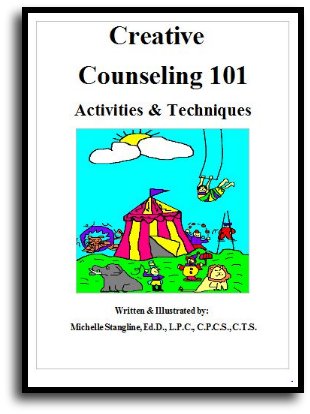
Step By Step Therapy:
Learn how to be a more Creative Therapist with the Book that started it all!
- Graduate School Counseling book used by hundreds of graduate counseling students!
- Includes full color reproducible worksheets with most activities.
- Winner of the Counselor Writer of the Year Award, 2011, Georgia Regional Award
Download Your Copy Today Only $39.95:
See Creative Counseling 101 eBook Information Here:
Get the Set
of all four
eBooks for only $98.95:
An incredible collection of how to do therapy eBooks!
A $159.80 Value,
You Save Over $60!
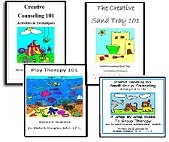
Get your complete set of the Creative Counseling 101.com eBooks by Dr. Michelle Stangline for only $98.95, that's less than $25.00 per eBook (Regular Price is $39.95 for each eBook.).
Your complete set includes:
- Creative Counseling 101
- Creative Group Counseling 101
- Creative Play Therapy 101
- Creative Sand Tray 101
For more information click the link below:
See Complete Set of eBooks For Sale Here:
New!!! "Beyond Art Therapy" 101 eBook
Over 300 pages of Beyond Art Therapy activities and techniques. Learn what I teach graduate counseling students!
See the link below for more information.
Only $39.95
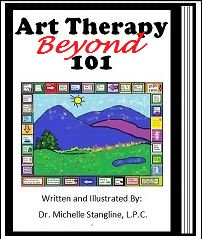
See More Invividual eBooks For Sale:
Sand Tray Therapy 101 eBook:
Learn how to do Sand Tray Therapy or enhance your skills.
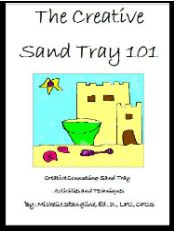
Play Therapy 101 eBook
Learn how to do play therapy or enhance your skills.
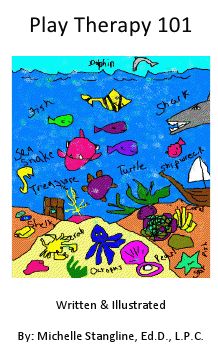
Small Group Counseling eBook For Sale:
Learn how to do creative group therapy and enhance your skills.
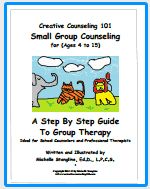
School Counselor Guidance Lesson & Social Stories eBook for sale:
Get a year's worth of school counselor guidance lessons with "Creative Warm & Fuzzy Classroom Guidance Lessons eBook". Introduce your students to the "Warm & Fuzzy Way". Click the link below for more information:
Warm & Fuzzy School Counselor Guidance Lessons eBook
